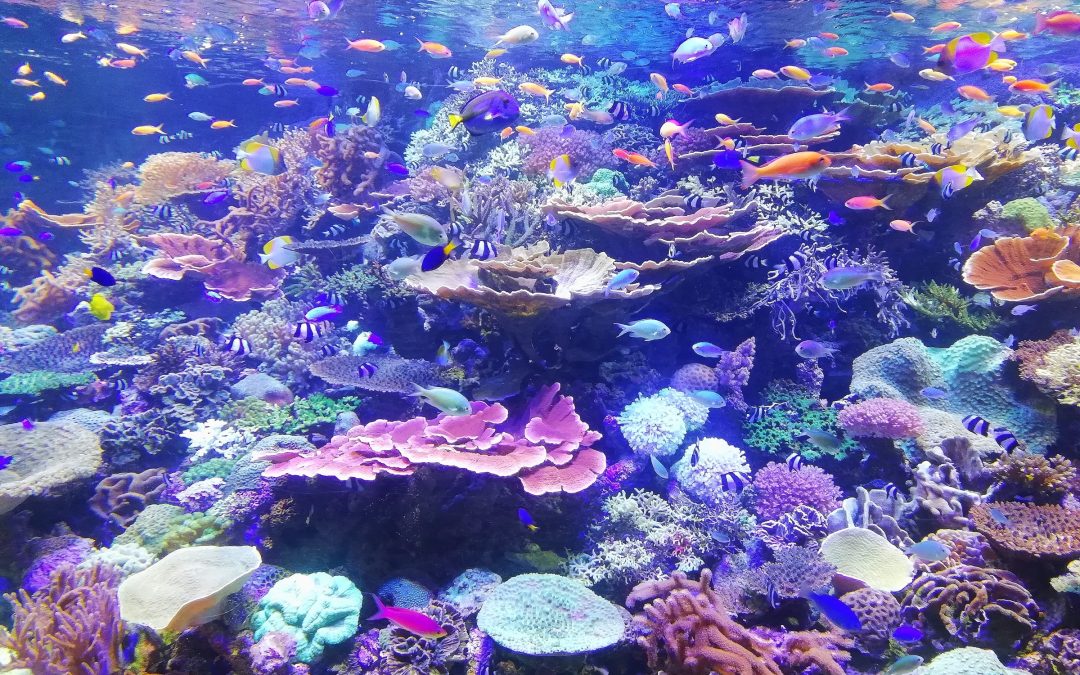
by DGR News Service | Apr 24, 2023 | Biodiversity & Habitat Destruction, Mining & Drilling, NEWS, Toxification
Editor’s Note: Earlier this year, UN delegates reached an agreement on conservation of marine life on international waters. The agreement, reached after two decades of negotiations, claims it will protect 30 percent of the world’s oceans from biodiversity loss by 2030. It has been hailed as a “breakthrough” by Secretary-General António Guterres. Mainstream environmental organizations have followed suit. These two articles by DGR members question these claims. They explore what the treaty actually says. The article is followed by the invitation to a demonstration against Deep Sea Mining in London on May 3 and 4.
The UN High Seas Treaty
By Jolene
Scrolling through a bright green Facebook page a few weeks ago I saw this headline: “More Than 190 Countries Agree On A Treaty to Protect Marine Life.” Sounds good, but is it really? I wonder if anyone who saw that post actually read and researched the story before reacting to it with likes and hearts and enthusiastic comments.
The article said that The United Nations High Seas Treaty aims to protect 30% of the world’s ocean from biodiversity loss by 2030. My first thought was, why only 30%? My second thought was, There’s got to be something more to this treaty than is being told to us in the article. And there is.
First, let’s look at who is allowed to use ocean resources.
Although the ocean body of water can be used by anyone, the ocean seabed belongs to the coastal state, which is 12 nautical miles from the coast. A nautical mile is a little over a land mile. Each state also has an exclusive economic zone which is 200 nautical miles from its coast. A nation has the right to use the resources in this zone. Beyond the 200 nautical miles is considered international waters — the high seas — which can be used by anyone. The new treaty is supposed to regulate the use of international waters.
Right now, all nations are allowed to lay submarine cables and pipelines along the floor bed of the high seas. That seems destructive enough, but now the UN High Seas Treaty, that is supposed to protect marine life, is going to allow deep sea mining to be exempt from environmental impact assessment (EIA) measures.
Deep sea mining is one of the most destructive activities that can be done to the ocean sea bed. The push for this mining is being driven by an increase in demand for minerals to make so-called renewable energy. More and more of the earth’s land is being mined for these minerals, and the mining industry is now looking to the ocean to continue the destruction.
The land and sea should not be owned by anyone, but as we can see, the most powerful people in this industrial society are just taking what they want. Mining destroys land bases, and now deep sea mining is being added to the destruction of the planet. Whenever governments get together to do something “good,” be very skeptical. It’s usually being done for the good of companies, not the planet.

Ocean Waves by Silas Baisch via Unsplash
What they aren’t telling you about the High Seas Treaty
By Julia Barnes
When the High Seas Treaty was announced, conservation groups applauded and social media was abuzz with celebration. The media portrayed it as a long-awaited victory. Commentators claimed that it meant 30% of the ocean would be protected by 2030, that deep sea mining would face strict regulations, and biodiversity would be safeguarded.
The draft text is easily accessible online. It’s a 54-page document, dry and tedious, but clear enough that any lay person should be able to comprehend its meaning.
That is why it is so unforgivable that the treaty has been misrepresented the way it has.
The High Seas Treaty does not guarantee that 30% of the ocean will be protected. It makes no commitment to a percentage, sets no targets. It merely lays out the regulatory framework under which it would be possible to create marine protected areas on the high seas.
When you think of a protected area, you’re likely imagining a place that is off limits to exploitation, where industrial activities are banned.
Under the High Seas Treaty, a protected area is one that is “managed” and “may allow, where appropriate, sustainable use provided it is consistent with the conservation objectives.”
I do not believe that humans possess the wisdom to manage the ocean, nor would we ever be capable of doing a better job than the ocean does itself, with its billions of years of intelligence.
Our track record with managing fisheries should cast serious doubts about our ability to assess sustainability. We must remember that there is no surplus in nature. When something is taken out, even at a rate that is “sustainable,” nutrients are permanently removed from the ecosystem. This cannot happen without consequences.
Even though “protected” might not mean what we expect it to, let’s assume for a moment that an area managed for “sustainable use” is in better shape than one left “unprotected.” Next, we run into the problem of enforcement.
Illegal fishing is rampant, with 40% of fishing boats in the world operating illegally. Marine protected areas are routine victims of poaching. Unless they deploy a navy to patrol the protected areas on the high seas, it is likely these will only be paper parks.
But all this presumes that marine protected areas will, in fact, be created. The process laid out in the treaty makes this quite difficult. With 193 signatory countries, decisions on the creation of marine protected areas are by consensus, and failing that, will require a two-thirds majority vote.
Proposals for new marine protected areas must undergo a review by a scientific and technical body, then consultation with “all relevant stakeholders,” after which the submitting party will be asked to revise the proposal.
Next, there is a 120-day review period. If another party objects to the establishment of a marine protected area within that time frame, the objecting party will be exempted from the marine protected area.
The review period also leaves time for industries to exploit the proposed area before protection is in place. We’ve seen this happen on land when logging companies targeted soon-to-be-protected forests, cutting as many trees as they could before the protection was granted. It’s not hard to imagine something similar taking place on the high seas, with a proposed area being fished intensively during the 120-day period.
What commentators often ignore is that a large portion of the treaty is dedicated to something called “marine genetic resources” and deals with how to share the “benefits” gained from commodifying the genetic material of marine organisms for use in things like pharmaceuticals.
Conservation groups have falsely claimed that the High Seas Treaty puts limits on deep sea mining, when in fact it does not. Deep sea mining is even exempted from environmental impact assessment measures.
The High Seas Treaty may have been a diplomatic feat, but as is often the case when negotiating with so many parties, to achieve agreement, the text ends up watered down and toothless.
This comes as no surprise. What is disheartening is seeing the way news media and NGOs consistently misrepresent the treaty. For a while, the internet exploded with erroneous claims that 30% protection had been achieved, that the ocean had scored a massive victory.
Meanwhile, the deep sea mining industry is gearing up to begin the largest and most destructive project ever imagined on the high seas, and few people have heard of it.
We have an illusion of protection masking a new era of exploitation.
Demonstration: Say No to Deep Sea Mining!
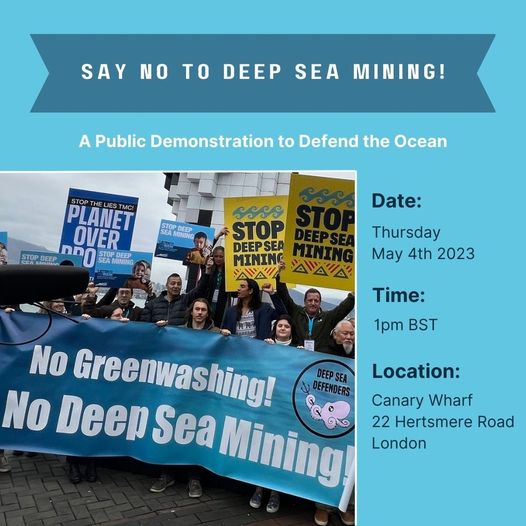
The International Forum for Deep Sea Mining Professionals will be holding their 11th Annual Deep Sea Mining Summit 2023 in London on May 3rd and 4th.
They have been very secretive about the exact location. Which is understandable considering the destructive nature of this profession. But we have found out where it will be held and we need to have an opposition demonstration there. Everyone and anyone in and around London who is against mining the deep sea should come with signs and solidarity. We have set a time and date to show up but feel free to come express your views anytime during the summit. On May 4th at 1pm BST in front of the London Marriott Hotel Canary Wharf 22 Hertsmere Road defend the deep sea!
Species extinction is considered a “likely outcome” of deep sea mining. This new extractive industry threatens not only the fragile seabed, but all levels of the ocean. Mining would produce plumes of sediment wastewater that spread for 100s of kilometers, suffocating the fish who swim throught them.
We have an opportunity to stop this industry before it begins, but we are running out of time. As soon as this July, commercial mining may begin, opening an area of the ocean as wide as North America to exploitation.
We want to show that there is widespread support for a ban on deep sea mining.
We also want to highlight the incredible biodiversity that is threatened, so we are encouraging people to come dressed as their favorite ocean creatures. Don’t let them think your silence means consent.
The Facebook page for this event is here.
Sponsored by Deep Sea Defenders
Featured Image: Life in the ocean by SGR via Unsplash

by DGR News Service | Apr 21, 2023 | ANALYSIS, Biodiversity & Habitat Destruction, Climate Change, Mining & Drilling
Editor’s Note: Mainstream environmental organizations propose electric vehicles (EVs) as a solution to every environmental crisis. It is not only untrue, but a delusion. It does not matter to the hundreds of lives lost whether they were killed for extraction of fossil fuel for traditional internal combustion (IC) cars, or for extraction of materials necessary for manufacturing EVs. What matters is that they are dead, never to come back, and that they died so a portion of humans could have convenient mobility. DGR is organizing to oppose car culture: both IC and EVs.
By Benja Weller
I am a rich white man in the richest time, in one of the richest countries in the world (…)
Equality does not exist. You yourself are the only thing that is taken into account.
If people realized that, we’d all have a lot more fun.
ZDF series Exit, 2022, financial manager in Oslo,
who illegally traded in salmon
Wir fahr’n fahr’n fahr’n auf der Autobahn
Vor uns liegt ein weites Tal
Die Sonne scheint mit Glitzerstrahl
(We drive drive drive on the highway
Ahead of us lies a wide valley
The sun shines with a glittering beam)
Kraftwerk, Single Autobahn / Morgenspaziergang, 1974
Driving a car is a convenient thing, especially if you live in the countryside. For the first time in my life I drive a car regularly, after 27 years of being “carless”, since it was left to me as a passenger. It’s a small Suzuki Celerio, which I call Celery, and fortunately it doesn’t consume much. Nevertheless, I feel guilty because I know how disturbing the engine noise and exhaust fumes are for all living creatures when I press the gas pedal.
So far, I have managed well by train, bus and bicycle and have saved a lot of money. As a photographer, I used to take the train, then a taxi to my final destination in the village and got to my appointments on time. Today, setting off spontaneously and driving into the unknown feels luxurious.
However, my new sense of freedom is in stark contrast to my understanding of an intact environment: clean air, pedestrians and bicyclists are our role models, children can play safely outside. A naive utopia? According to the advertising images of the car industry, it seems as if electric cars are the long-awaited solution: A meadow with wind turbines painted on an electric car makes you think everything will be fine.

“Naturally by it’s very nature.” says the writing on an EV of the German Post, Neunkirchen, Siegerland (Photo by Benja Weller)
In Germany, the car culture (or rather the car cult) rules over our lives so much that not even a speed limit on highways can be achieved. The car industry has been receiving subsidies from the government for decades and journalists are ridiculed when they write about subsidies for cargo bikes.
Right now, this industry is getting a green makeover: quiet electric cars that don’t emit bad air and are “CO2 neutral” are supposed to drive us and subsequent generations into an environmentally friendly, economically strong future. On Feb. 15, 2023, the green party Die Grünen published in its blog that the European Union will phase out the internal combustion engine by 2035: “With the approval of the EU Parliament on Feb. 14, 2023, the transformation of the European automotive industry will receive a reliable framework. All major car manufacturers are already firmly committed to a future with battery-electric drives. The industry now has legal and planning certainty for further investment decisions, for example in setting up its own battery production. The drive turnaround toward climate-friendly vehicles will create future-proof jobs in Europe.”
That’s good news – of course for the automotive industry. All the old cars that will be replaced with new ones by 2035 will bring in more profit than old cars that will be driven until they expire. That the EU along with the car producers, are becoming environmentalists out of the blue is hard to believe, especially when you see what cars drive on German roads.
In recent years, a rather opulent trend became apparent: cars with combustion engines became huge in size and gasoline consumption increased, all in times of ecological collapse and global warming. These oversized SUVs are actually called sport-utility vehicles, even if you only drive them to get beer at the gas station. Small electric cars seem comfortable enough and have a better environmental footprint than larger SUVs. But the automotive industry is not going to let the new electromobility business go to waste that easily and is offering expensive electric SUVs: The Mercedes EQB 350 4matic, for example, which weighs 2.175 tons and has a 291-hp engine, costs €59,000 without deducting the e-car premium.
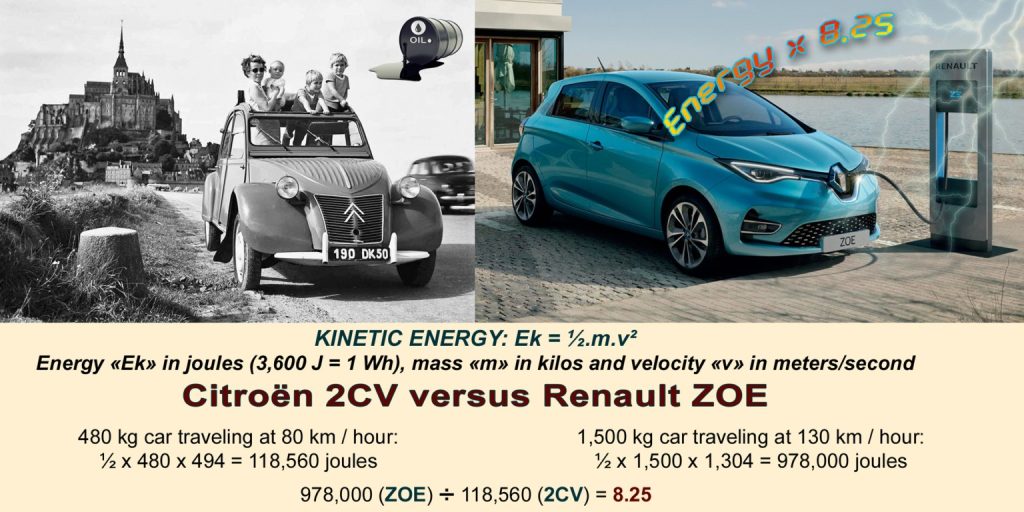
Comparing the Citroen 2CV and the Renault Zoe electric car shows that the Zoe uses about 8 times more kinetic energy. (Graph by Frederic Moreau)
If we look at all the production phases of a car and not just classify it according to its CO2 emmissions, the negative impact of the degradation of all the raw materials needed to build the car becomes visible. This is illustrated by the concept of ecological backpack, invented by Friedrich Schmidt-Bleek, former head of the Material Flows and Structural Change Department at the Wuppertal Institute for Climate, Environment and Energy. On the Wuppertal Institute’s website, one can read that “for driving a car, not only the car itself and the gasoline consumption are counted, but also proportionally, for example, the iron ore mine, the steel mill and the road network.”
“In general, mining, the processing of ores and their transport are among the causes of the most serious regional environmental problems. Each ton of metal carries an ecological backpack of many tons, which are mined as ore, contaminated and consumed as process water, and weigh in as material turnover of the various means of transport,” the Klett-Verlag points out.
Car production requires large quantities of steel, rubber, plastic, glass and rare earths. Roads and infrastructure suitable for cars and trucks must be built from concrete, metal and tar. Electric cars, even if they do not emit CO2 from the exhaust, are no exception. Added to this is the battery, for which electricity is needed that is generated at great material expense, a never-ending cycle of raw material extraction, raw material consumption and waste production.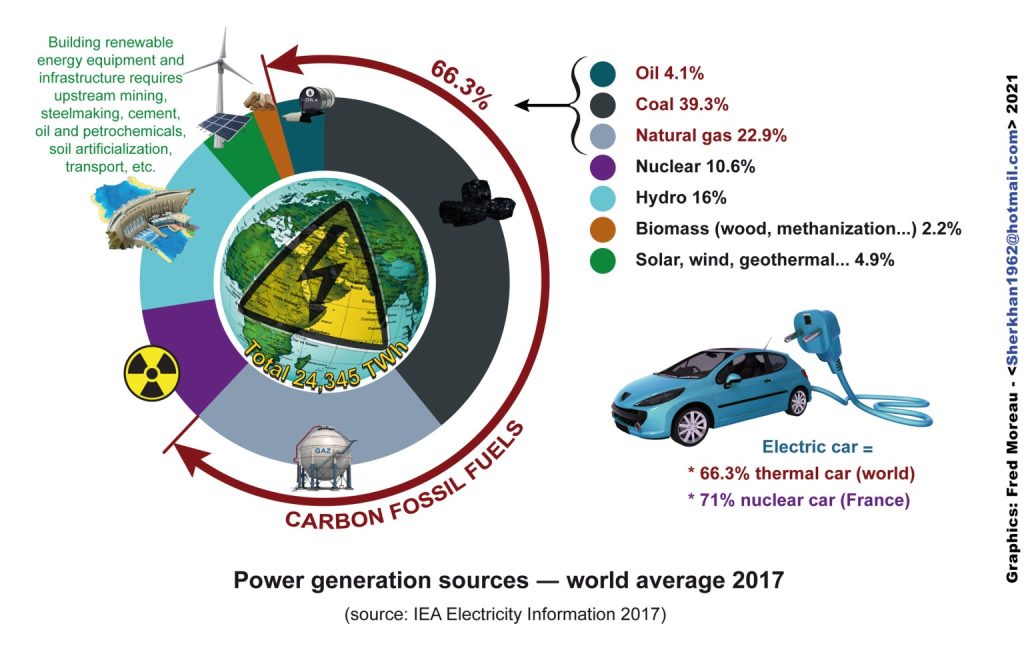
Power generation sources for electric vehicles (Graph by Frederic Moreau)
Lithium is a component of batteries needed for electric cars. For the production of these batteries and electric motors, raw materials are used “that are in any case finite, in many cases already available today with limited reserves, and whose extraction is very often associated with environmental destruction, child labor and overexploitation,” as Winfried Wolf writes in his book Mit dem Elektroauto in die Sackgasse, Warum E-Mobilität den Klimawandel beschleunigt (With the electric vehicle into the impasse, why e-mobility hastens climate change).
What happens behind the scenes of electric mobility, which is touted as “green,” can be seen in the U.S. campaign Protect Thacker Pass. In northern Nevada, a state in the western U.S., resistance is stirring against the construction of an open-pit mine by the Canadian company Lithium Americas, where lithium is to be mined. Here, a small group of activists, indigenous peoples and local residents have united to raise awareness of the destructive effects of lithium mining for electric car batteries and to prevent the lithium mine in the long term with the Protect Thacker Pass campaign.
Thacker Pass is a desert area (also called Peehee muh’huh in the native language of the Northern Paiute) that was originally home to the indigenous peoples of the Northern Paiute, Western Shoshone, and Winnemuca Tribes. The barren landscape is still home to some 300 species of animals and plants, including the endangered Kings River pyrg freshwater snail, jack rabbit, coyote, bighorn sheep, golden eagle, sage grouse, and pronghorn, and is home to large areas of sage brush on which the sage grouse feeds 70-75% of the time, and the endangered Crosby’s buckwheat.
For Lithium Americas, Thacker Pass is “one of the largest known lithium resources in the United States.” The Open-pit mining would break ground on a cultural memorial commemorating two massacres perpetrated against indigenous peoples in the 19th century and before. Evidence of a rich historical heritage is brought there by adjacent caves with burial sites, finds of obsidian processing, and 15,000-year-old petroglyphs. For generations, this site has been used by the Northern Paiute and Western Shoshone tribes for ceremonies, traditional gathering and hunting, and educating young Native people. Now it appears that the history of the colonization of Thacker Pass is repeating itself.
According to research by environmental activists, the lithium mine would lower the water table by 10 meters in one of the driest areas in the U.S., as it is expected to use 6.4 billion gallons of water per year for the next 40 years. This would be certain death for the Kings River pyrg freshwater snail. Mining one ton of lithium generally consumes 1.9 million liters of water at a time when there is a global water shortage.
The mine would discharge uranium, antimony, sulfuric acid and other hazardous substances into the groundwater. This would be a major threat to animal and plant species and also to the local population. Their CO2 emissions would come up to more than 150,000 tons per year, about 2.3 tons of CO2 for every ton of lithium produced. So much for CO2-neutral production! Thanks to a multi-billion dollar advertising industry, mining projects are promoted as sustainable with clever phrases like “clean energy” and “green technology”.
About half of the local indigenous inhabitants are against the lithium mine. The other half are in favor of the project, hoping for a way out of financial hardship through better job opportunities. Lithium Americas’ announcement that it will bring an economic boost to the region sounds promising when you look at the job market there. But there’s no guarantee that working conditions will be fair and jobs will be payed well. According to Derrick Jensen, jobs in the mining industry are highly exploitative and comparable to conditions in slavery.
Oro Verde, The Tropical Forest Foundation, explains: “With the arrival of mining activities, local social structures are also changing: medium-term social consequences include alcohol and drug problems in the mining regions, rape and prostitution, as well as school dropouts and a shift in career choices among the younger generation. Traditional professions or (subsistence) agriculture are no longer of interest to young people. Young men in particular smell big money in the mines, so school dropouts near mines are also very common.”
Seemingly paradoxically, modern industrial culture promotes a rural exodus, which in turn serves as an argument for the construction of mines that harm the environment and people. Indigenous peoples have known for millennia how to be locally self-sufficient and feed their families independently of food imports. This autonomy is being repeatedly snatched away from them.
Erik Molvar, wildlife biologist and chair of the Western Watersheds Project, says of the negative impacts of lithium mining in Thacker Pass that “We have a responsibility as a society to avoid wreaking ecological havoc as we transition to renewable technologies. If we exacerbate the biodiversity crisis in a sloppy rush to solve the climate crisis, we risk turning the Earth into a barren, lifeless ball that can no longer sustain our own species, let alone the complex and delicate web of other plants and animals with which we share this planet.”
We share this planet with nonhuman animal athletes: The jack rabbit has a size of about 50cm (1.6 feet), can reach a speed of up to 60 km/h (37mph) and jump up to six meters (19.7 feet) high from a standing position. In the home of the jack rabbit, 25% of the world’s lithium deposits are about to be mined. To produce one ton of lithium, between 110 and 500 tons of earth have to be moved per day. Since lithium is only present in the clay rock in a proportion of 0.2-0.9%, it is dissolved out of the clay rock with the help of sulfuric acid.
According to the Environmental Impact Statement from the Thacker Pass Mine (EIS), approximately 75 trucks are expected to transport the required sulfur each day to convert it to sulfuric acid in a production facility built on site. This means that 5800 tons of sulfuric acid would be left as toxic waste per day. Sulfur is a waste product of the oil industry. How convenient, then, that the oil industry can simply continue to do “business as usual.”
Nevada Lithium, another company that operates lithium mines in Nevada states: “Electric vehicles (EVs) are here. The production of lithium for the batteries they use is one of the newest and most important industries in the world. China currently dominates the market, and the rest of the world, including the U.S., is now responding to secure its lithium supply.” The demand for lithium is causing its prices to skyrocket: Since the demand for lithium for the new technologies is high and the profit margin is 46% according to Spiegel, every land available will be used to mine lithium.
Lithium production worldwide would have to increase by 400% to meet the growing demand. With this insane growth rate as a goal, Lithium Americas has begun initial construction at Thacker Pass on March 02, 2023. But environmentalists are not giving up, they are holding meetings, educating people about the destructive effects of lithium mining, and taking legal action against the construction of the mine.
Let’s take a look at the production of German electric cars.
Meanwhile, this is the third attempt to bring electric cars to the market in Germany. In the early 20th century, Henry Ford’s internal combustion engine cars replaced electric-powered cars on the roads.
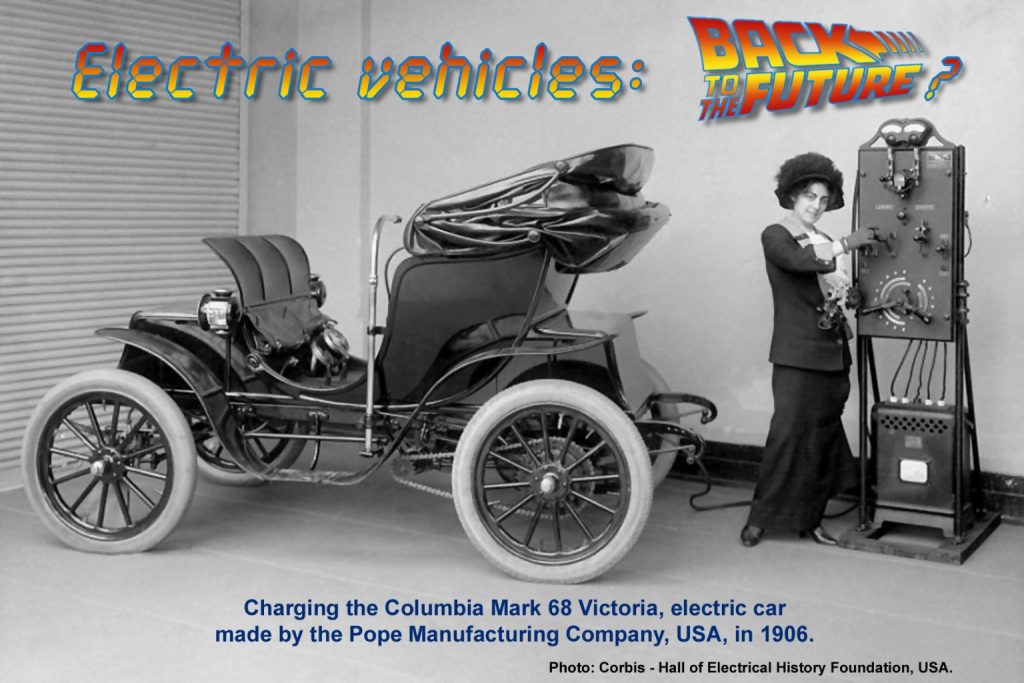
Graph by Frederic Moreau
“In fact, three decades ago, there were similar debates about the electric car as today. In 1991, various models of electric vehicles were produced in Germany and Switzerland,” writes Winfried Wolf. “At that time, it was firmly assumed that the leading car companies would enter into the construction of electric cars on a large scale.”
He goes on to write about a four-year test on the island of Rügen that tested 60 electric cars, including models by VW, Opel, BMW and Daimler-Benz passenger cars from 1992 to 1996. The cost was 60 million Deutsche Mark. The Institute for Energy and Environmental Research (IFEU) in Heidelberg, commissioned by the Federal Ministry of Research, concluded that electric cars consume between 50 percent (frequent drivers) and 400 percent more primary energy per kilometer than comparable cars with internal combustion engines. The test report states that the Federal Environment Agency (UBA) in Berlin also sees its rejection of the electric car strategy confirmed.
There is no talk of these test results in times of our current economic crisis: also German landscapes and its water bodies must make way for a “green” economic policy. We can see the destructive effects of electric car production centers in the example of Grünheide, a town in Brandenburg 30 km from Berlin.
Manu Hoyer, together with other environmentalists in the Grünheide Citizens’ Initiative, rebel against the man who wants to discover life on other planets because the Earth is not enough: Elon Musk. She explains in an article by Frank Brunner in the magazine Natur how Tesla proceeded to build the Gigafactory Berlin-Brandenburg with supposedly 12,000 employees: First, they deforested before there was even a permit, and when it was clear that the electric car factory would be built, Tesla planted new little trees elsewhere as compensation.
The neutral word “deforestation” does not explain the cruel process behind it: Wildlife have their habitat in trees, shrubs and in burrows deep in the earth. In the Natur article, Manu Hoyer recalls that the sky darkened “with ravens waiting to devour the dead animals among the felled trees.”
In the book The Day the World Stops Shopping, J.B. MacKinnon describes, based on a study of clearing in Australia, that the scientific consensus is that the majority, and in some cases all, of the individuals living at a site will die when the vegetation disappears.
It doesn’t sound pretty, but it’s the reality when you read that animals are “crushed, impaled, mauled or buried alive, among other things. They suffer internal bleeding, broken bones or flee into the street where they are run over.” Many would stubbornly resist giving up their habitat.
In this, they are like humans. Nobody gives up her piece of land or his house without a fight when it is taken away from him; animals and humans both love the good life. But the conditions of wild animals play no role in our civil society, they should be available anytime to be exlpoited for our needs.
In order not to incite nature lovers, legal regulations are supposed to lull them into the belief that what is happening here is morally right. Behind this is a calculus by the large corporations, which in return for symbolic gestures can continue the terror against nature blamelessly.
In December 2022, Tesla was granted permission to buy another 100 hectares of forest to expand the car factory site to 400 hectares. The entire site had long been available for new industrial projects, although it is also a drinking water protection area. The Gigafactory uses 1.4 million cubic meters of water annually in a federate state plagued by drought.
Manu Hoyer tells Deutschlandfunk radio that dangerous chemicals are said to have leaked only recently and contaminated firefighting water seeped into the groundwater during a fire last fall. Another environmentalist, Steffen Schorcht, who studied biocybernetics and medical technology, criticizes local politicians for their lethargy in the face of environmental destruction. He sees no other way to fight back than to join forces with other citizens and international organizations outside of politics.
The beneficiaries are not the people who make up the bulk of the population. Tesla cars go to drivers who are happy to spend 57,000€ for a car with a maximum of 535 horsepower.
I can still remember how, as a child, I used to drive with my parents on vacation to the south of France, Italy or Austria in the Citroën 2CV model (two horsepower). Such a car trip was more adventure than luxury, but the experiences during the simple camping vacations in Europe’s nature have remained formative childhood memories.
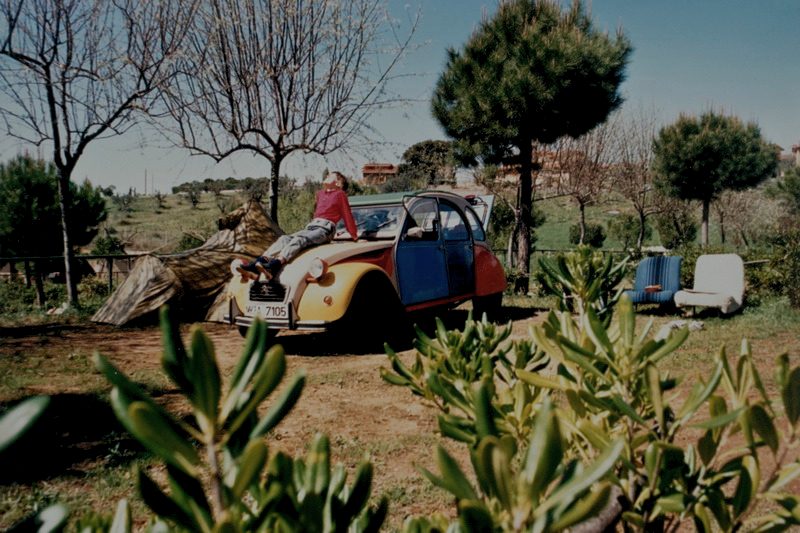
The author sitting on the hood of a Citroën 2CV in Tuscany, Italy, 1989 (Photo: private)
Today, we have to go a big step further than just living a “simple life” individually. The car industry is pressing the gas pedal, taking the steering wheel out of our hands and driving us into the ditch. It’s time to get out, move our feet and stand up against the car industry.
The BDI, Federation of German Industries, writes in its 2017 position paper on the interlocking of raw materials and trade policy in relation to the technologies of the future that without raw materials there would be no digitalization, no Industry 4.0 and no electromobility. This statement confirms that our western lifestyle can only be financed through the destruction of the last natural habitats on Earth.
The mining of lithium and other so-called “raw materials” for new technologies is related to our culture, which imposes a techno-dystopia on the functioning organism Earth, that nullifies all biological facts. If we want to save the world, it seems to me, we should not become lobbyists for the electric car industry. Rather, we should organize collectively, learn from indigenous peoples, defend the water, the air, the soil, the plants, the wildlife, and everyone we love. The brave environmentalists in Grünheide and Thacker Pass are showing us how.
Homo sapiens have done well without cars for 200,000 years and will continue to do so. All we need is the confidence that our feet will carry us.
Wir fahr’n fahr’n fahr’n auf der Autobahn, Kraftwerk buzzed at the time
as an ode to driving a car
I glide over the asphalt to the points in lonely nature,
give myself a time-out from the confines of the small town
Bus schedules in German villages are an old joke
Buy me a Mercedes Benz, cried Janis Joplin devotedly,
without an expensive car, life is only half as valuable
Car-free Sundays during the oil crisis as a nostalgic anecdote
Driving means freedom and compulsion at the same time, asphalt is forced upon topsoil
with millions of living beings per tablespoon of earth
You must go everywhere: To the supermarket, to school, to work, to the store,
to the club, to friends, and to the trail park
Be yourself! they tell you, but without a car you’re not yourself,
on foot with a lower social status than on wheels
The speed limit dismissed each time, which party stands for the wild nature,
our ancient living room? Don’t vote for them, they deceive too
Believe yourself! they say, but what else can you believe, grown up believing
that this civilization is the only right one
Drive, drive, drive and the airstream flies in your hair –
Freedom, the one moment you have left
Featured image: A view of Thacker Pass by Max Wilbert
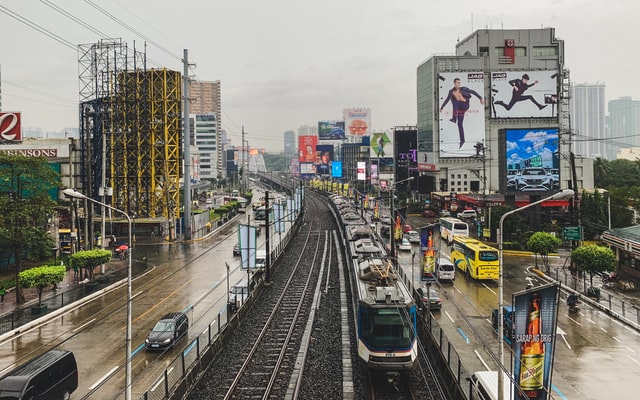
by DGR News Service | Apr 17, 2023 | ANALYSIS, Alienation & Mental Health, Human Supremacy, The Problem: Civilization
Editor’s Note: The Earth is dying. The facts are there. Yet, not a lot of people take it seriously. Otherwise, we would have seen a much greater action around it. The following post tries to explain this phenomenon by the concepts of enlightenment, wétiko, denial of reality and maximum power principle, and by challenging the preconceived notions in our civilization.
By Erik Michaels/Problems, Predicaments and Technology
My last post about enlightenment was to describe the simple fact that enlightenment does not bring happiness or fulfillment but is a stripping away of innocence and naïvety. Enlightenment is what experience and reality replaces idealism with. My own experience informs me that I must choose to look for positives rather than the negatives which initially overwhelm me. I must turn away from the anthropocentric perspective which I am naturally biased with. In this manner, I can then begin to look at the collective set of predicaments our species has brought forth and see it for the unvarnished truth that it really is. My writings aren’t unique, as many others write about the same topics as I do. However, very few actually point to the actual roots of these predicaments the way I do, and perhaps denial of reality (see link below) is one reason why. Doing so requires much grief work along the way, realizing the true nature of how we got to this point.
I brought the concept of wétiko into that post (as well as many others), and an article from Max Wilbert about Protect Thacker Pass made me realize that I should probably expand on this concept as well as point out the reasons for it. In the article, he quotes Jack D. Forbes, and then goes on to explain here, quote:
“‘The wétiko psychosis, and the problems it creates, have inspired many resistance movements and efforts at reform or revolution. Unfortunately, most of these efforts have failed because they have never diagnosed the wétiko as an insane person whose disease is extremely contagious.’
That contagion is dangerous. None of us are immune. This is why all of humanity’s most lasting stories, from the Wendigo to Star Wars, tell of internal conflict. Whether you call it greed, temptation, evil, the Dark Side of the Force, or anything else, humans have the capacity for doing wrong.“
It was that very part which is so powerful that made me see that I need to expand on it to bring the reality of precisely what it is into the forefront. Most people brought up in western civilization cannot “see” wétiko because they are indoctrinated against it. (Go here for an indepth and complete description of what civilization is.) Elementary schools teach history in such a way as to present Europeans as the “good guys” and North American Indians as the “bad guys” when in reality, it is the other way around from an ecological standpoint. European cultures invaded North American Indians’ lands and used their superior technology to wipe out or marginalize the Indians wherever resistance was mounted. This same colonialism has presented itself time and time again all over the world, where a force with superior technology has wiped out culture after culture and relegated such cultures to history. The trouble with this is in the fact that those cultures actually lived in a far more sustainable relationship with their environment than most all of us today.
Most of us in western civilization look at land ownership, agriculture, and civilization itself as part of who we are, including our economic systems and cultural systems. Until one learns the reality about these systems being unsustainable, one almost never questions their necessity or their presence. Once one questions the presence and the necessity of continuing these systems, one becomes aware of the fact that humans lived without these systems for most all of our entire history except the last ten to twelve thousand years (in the case of civilization) and only the last 200 years or so has been industrial civilization.
“The less you think about your oppression, the more your tolerance for it grows. After a while, people just think oppression is a normal state of things. But to become free, you have to be acutely aware of being a slave.” ~ Assata Shakur
This quote is poignant due to precisely the predicament we find ourselves in. Now, I still do not think that 8 billion or more human beings can live on this planet in a sustainable manner, regardless of how they live simply due to the fact that in order to provide habitat to that many humans more or less requires an amount of energy for habitat greater than can be provided through renewable resources (provided by photosynthesis). Still, there is no doubt in my mind that the humans who are alive today could live far more sustainably than those of us who live the Western Civilization lifestyle. The oppression most all of us face has to do with technology use, civilization, and the economic system currently being used, among many other items commonly discussed in the social justice realm.
Whether one calls the set of circumstances we find ourselves in a predicament, a multi-polar trap, dilemma, or something having a similar meaning as these, this set of circumstances is far different than a problem. This set of circumstances cannot be solved or answered with a simple solution or even a set of solutions. Even if the entirety of human population right now could cease all anthropogenic emissions immediately (something which is utterly impossible), ecological overshoot and climate change and many other symptom predicaments of overshoot would continue unabated (see Denial of Reality for the evidence). While eliminating emissions would be a really nice start to mitigating climate change, as long as overshoot is allowed to continue, we would have accomplished very little. The only way to reduce overshoot is to reduce technology use – in other words, we will need to promote degrowth and the abandonment of the system of civilization, because it is unsustainable. Civilization is supported by technology use and cannot exist without it. Even back when our species lived mostly in a sustainable fashion, we only did so after causing destruction first (usually in the form of wiping out the species we relied on for our very existence) and learning from our mistakes. Still, most Indigenous societies learned these lessons and even today still live in a mostly sustainable fashion compared to those living in the system of civilization.
Ultimately, Indigenous cultures found a way to live more or less in a subsistence lifestyle and did so in a very fulfilled way, being supported by other members of their society. Because each member felt supported by the other members, there was generally little unhappiness. If a member felt unhappy about something, it was discussed with others who helped the member come to terms with whatever ailed him or her.
Getting back to Max Wilbert’s quote, we see that wétiko psychosis is the cause of our undoing and that it is very contagious. How does this present itself in society? Take any form of technology from simple to complex and show a person unfamiliar with said technology this tool to help this person through his or her day. How likely would a person reject this new form of help, especially if you are his or her friend and YOU have it and are using it? Start with simple stone tools and progress through today’s computerized systems, robotics, AI systems (who hasn’t seen someone posting about ChatGPT?), cars, electricity, medical technology and so on. What you have just witnessed is the Maximum Power Principle in action. This is precisely what causes our lack of agency with regard to so many different topics, and also what causes the root issue of our unsustainability. For those who still believe in free will, go back to these articles I have linked here and read them. It took me a long time to accept the reality and I am all too painfully aware that providing the facts and evidence won’t change your mind because if it did, you would no longer have the impediment of that belief since it doesn’t exist:
“You can’t convince a believer of anything; for their belief is not based on evidence, it’s based on a deep seated need to believe.” ~Carl Sagan
As for folks who think we have the ability to go against the Maximum Power Principle, you are actually correct – we can go against it (in a sense). This is exactly what most Indigenous cultures did upon coming into contact with European cultures. The European cultures then subsequently wiped them out or sidelined them onto reservations because they held superior technology. I would even go as far to say that we should go against the MPP to the extent possible. This has been the attempt almost every activist has made at one point or another. However, we will then be fighting those who have superior technology and weapons (society will first label troublemakers as terrorists and use superior technology against those folks), and one can clearly see how that battle ends up. Some people may gasp at the reality of robotic dogs with mounted machine guns, but look at the technology that is available to the average person now! At the end of the day, going against the MPP is something that will only result in actually making a difference once everyone agrees that reducing ecological overshoot through reducing technology use, promoting degrowth, and promoting the abandonment of civilization is the correct way to handle the set of predicaments we have gotten ourselves into. The real question is this: Will that day ever come? I’m not going to hold my breath. As long as there are still people who choose to continue living under the system of civilization, they will consume and utilize the energy and resources that those of us who choose to conserve said energy and resources do not use, undoing any progress along the way. As long as there are those who resist giving up modern technology and civilization, reducing ecological overshoot becomes a test of character because we ALL live on the same planet. For anyone still believing otherwise, perhaps the shopping cart theory story might convince you that there are many reasons that society might still choose to live under our current systems rather than attempt to abandon it despite it being unsustainable. One last reason we lack agency is Bonhoeffer’s Theory of Stupidity I posted quite sometime ago.
The conclusion I have come to based upon all the evidence is one that I do not like at all; but one that I cannot deny either. We have very little if any agency to be able to do anything better than what is being done right now as long as there is still relative abundance. Only when the pain becomes too great will most people change their behavior, and this quote reminds me of this fact:
No one changes unless they want to. Not if you beg them. Not if you shame them. Not if you use reason, emotion, or tough love. There’s only one thing that makes someone change: their own realization that they need to do it. And there’s only one time it will happen: when they decide they’re ready. ~Unknown
Once one sees the enlightenment that I have disclosed in recent articles (going back to November) and comprehends our collective and individual lack of agency to be able to make serious change during this time of relative abundance, the best one can do is to follow their own conscience and to Live Now.
Featured image: via UnsplashPhoto by Gino on Unsplash
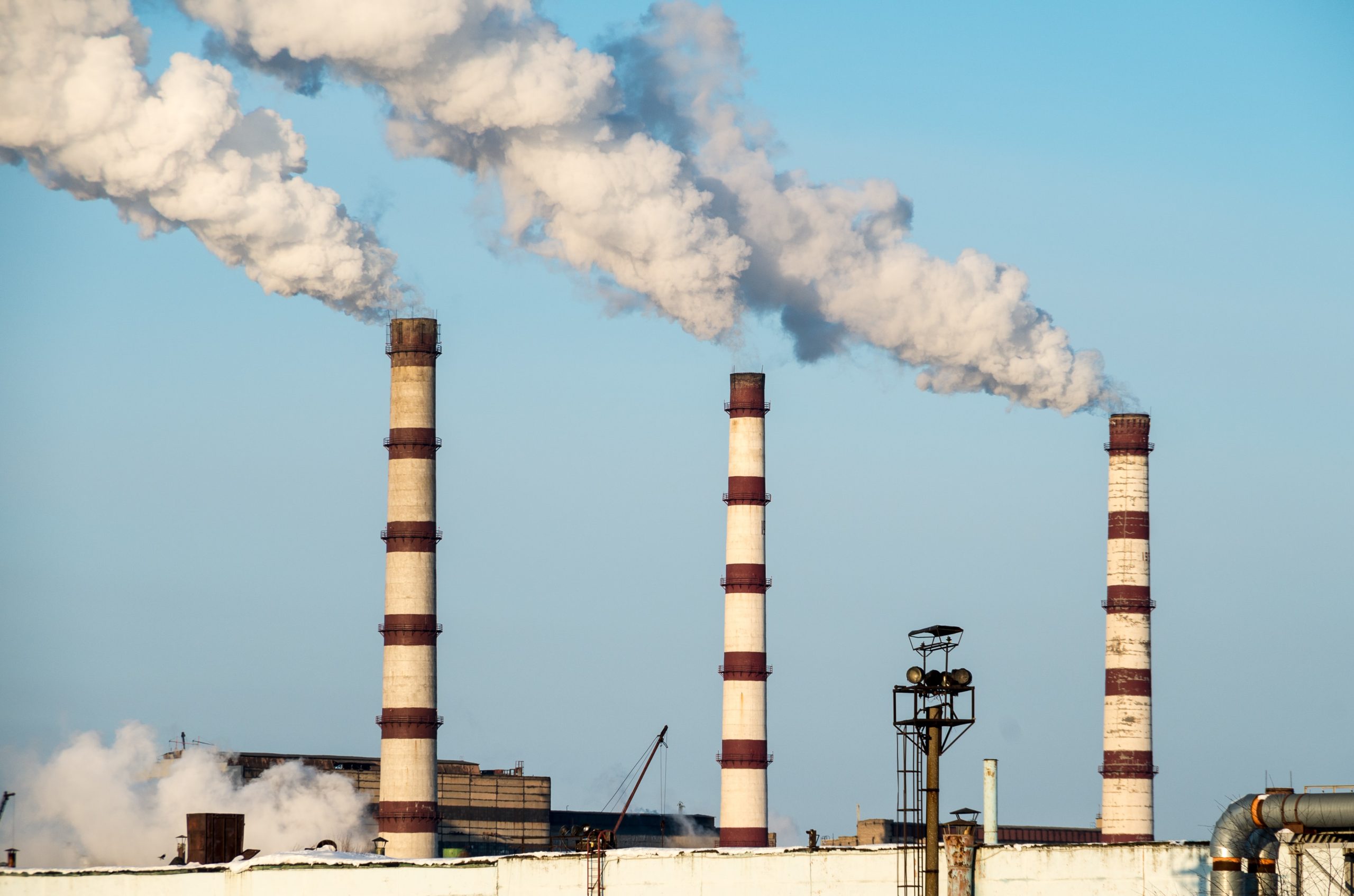
by DGR News Service | Apr 14, 2023 | ANALYSIS, Colonialism & Conquest, The Problem: Civilization, Toxification
Editor’s Note: The civilization has destroyed many places in the name of progress, which they call ‘sacrifice zones.’ The following piece discusses different instances of destruction from recent history, and how the current economy has actively profited from those destructions. The views expressed in the article are of the author. DGR does not necessarily agree with all of the opinions expressed.
By Mankh
Considering the destruction caused by extractive mining and wars, the global corporate empire society sure seems like one huge controlled demolition. Before getting to the topic of Electric Vehicles (EVs) and specifically Thacker Pass aka Peehee Mu’huh, some examples and explanation of the context of controlled demolition.
Currently in Ukraine, various governments/investors are making bank on both ends of the stick: from the weapons manufacturers destruction end AND the BlackRock, Inc. (an American multi-national investment company) et al reconstruction end. A December 2022 CNBC headline spilled the beans: “Zelenskyy, BlackRock CEO Fink agree to coordinate Ukraine investment” and more recently: “The estimated cost of Ukraine’s reconstruction and recovery bill has grown to $411 billion.” — while US infrastructure crumbles. A key aspect of the reconstruction is multinational agri-businesses salivating over Ukraine’s rich soil, something rarely mentioned in umpteen war analyses.
Speaking of crumbling infrastructure, the derailed train and subsequent deliberate explosions of toxic chemicals in Palestine, Ohio (which includes rivers), has created an environmental disaster; another controlled demolition because lack of care for railroad maintenance and extra care for dollars helped create the accident waiting to happen.
From an article by Tish O’Dell and Chad Nicholson:
“Three days after the derailment, on Feb. 6, we watched as Ohio Gov. Mike DeWine, in consultation with Norfolk Southern representatives, greenlighted a plan to blow holes in five of the cars containing toxic chemicals, which would lead to a ‘controlled release,’ and residents in nearby communities were ordered to evacuate. … By Feb. 7, according to a Norfolk Southern service alert, trains were running through East Palestine again. As thousands of dead fish floated in local waterways, as nearby residents were reporting sickness and dying pets, as untold long-term health and environmental problems lurked in the hazy future, the railroad chugged back to business as usual.”
Also sadly, “East Palestine Soil Contains Dioxin Levels Hundreds of Times Over Cancer Risk Threshold”
The broader issue to consider is this: controlled demolition requires careful preparation or deliberate lack there of—and then with the virtual flick of a switch, it happens . . . like dominoes. And a ‘new reality’ is created. What quickly followed the 9-11 attacks was the Global War Of Terror, later determined to have been riddled with lies.
After Covid-19 began, there were lockdowns and a slew of enforced restrictions, many of which were later deemed unwarranted. The world changed in a flash, as did the economy, with many small and some larger businesses going bust, as the elite rich got richer. Yet whatever one’s opinion about all that, the message from the natural world was quiet and clear: rivers and skies cleared up! . . . showing that healing can happen quickly―if we drastically curtail the business as usual of industrial capitalism.
After Ukraine re-began with Russia’s attacks (because the situation ‘began’ in 2014 with the Maidan/neo-Nazi coup overthrowing elected Ukrainian President Viktor Yanukovych) . . . economic sanctions, global economic shake-ups-and-downs, nuclear saber rattling, and more, including the above mentioned agri-business ploy, which, by the way, is also global, as, for example, Bill Gates is “the largest landowner in the U.S.,” owning “270,000 acres spread across 18 different states.”
A Twitter post on March 20, 2023, by esteemed journalist and filmmaker John Pilger, succinctly sums up the media-military-complex modus operandi:
And though not as visibly dramatic, preparations for controlled demolition are happening again with the deliberate push for EVs (Electric Vehicles). For example, in New York, November 2022:
“Governor Kathy Hochul signed legislation that will advance clean transportation efforts by removing barriers to the installation of electric vehicle charging stations on private property.”
&
“The Charge NY initiative offers electric car buyers the Drive Clean Rebate of up to $2,000 for new car purchases or leases. Combine that with a Federal Tax Credit of up to $7,500, and it’s an opportunity you wouldn’t want to miss. If you are a New York State resident looking for a new car, it’s a great time to buy or lease a plug-in hybrid or battery-powered car that qualifies for the Drive Clean Rebate.”
As any reader of Deep Green Resistance News Service and those following or participating in the efforts to Protect Thacker Pass knows, “clean” is false advertising and you would want to resist the opportunity. In the broad case of EVs, we, as human beings and as consumers have choices that can affect or re-direct the trajectory of this huge deliberate push for EVs, which is a kind of heating up of boiled frogs controlled demolition . . . because if not stopped, suddenly EVs will dominate the roads and landscapes, while sacred habitats and Native lands are destroyed.
As lawyer and Protect Thacker Pass co-founder Will Falk has alluded to in various interviews and videos, many aspects of the legal system are rigged in favor of government and corporate control of mining; this is a form of control with the goal of demolition of habitat and wildlife, too-often along with desecration of Native lands for profit.
I don’t have the answers for how to stop such control freak factors, but at least recognizing that there are various preparations so that a demolition ‘goes smoothly’ will help each person/group/organization find a best way to participate so as to help prevent specific preparations and perhaps prevent the controlled demolition of Thacker Pass aka Peehee Mu’huh, as well as other sacred site hot spots.
The natural world of plants also has an array of unseen or barely visible preparations until . . . a flower buds then blooms or fruit ripens; let’s call that process a controlled creation or the unfolding of innate potential, as with a seed. This is what those who care about the Earth work hard to defend, protect, and preserve—the natural cycles.
Further demolition examples
In 2017, investigative journalist, author and filmmaker Greg Palast reported:
“…an eyewitness with devastating new information about the Caspian Sea oil-rig blow-out which BP had concealed from government and the industry.
The witness, whose story is backed up by rig workers who were evacuated from BP’s Caspian platform, said that had BP revealed the full story as required by industry practice, the eleven Gulf of Mexico workers ‘could have had a chance’ of survival. But BP’s insistence on using methods proven faulty sealed their fate.
One cause of the blow-outs was the same in both cases: the use of a money-saving technique, plugging holes with ‘quick-dry’ cement. By hiding the disastrous failure of its penny-pinching cement process in 2008, BP was able to continue to use the dangerous methods in the Gulf of Mexico, causing the worst oil spill in U.S. history.”
As with East Palestine and umpteen other so-called disasters, cutting corners for profit is too-often a factor with controlled demolitions.
“Disasters like these keep happening because the system — the train — keeps rolling, exactly as it was designed to, foisting the consequences onto communities and their environments and hoarding the spoils for the economic elites, while government regulatory agencies issue permits and legalize it all.
“Since this country’s founding, our system of government has placed profits and property interests over people and planet. The derailment in East Palestine illustrates this clearly. For over 150 years, railroad workers have been telling employers like Norfolk Southern and the government that their working conditions are deplorable and dangerous.
“With deregulation of the industry in the 1980s, which included Wall Street mergers and ’short term profit imperatives,’ trains have been getting longer and longer while the number of train workers gets smaller and smaller.”
In Cobalt Red: How the Blood of the Congo Powers Our Lives, Siddharth Kara writes:
“Villages along the road are coated with airborne debris. There are no flowers to be found. No birds in the sky. No placid streams. No pleasant breezes. The ornaments of nature are gone. All color seems pale and unformed. Only the fragments of life remain. This is Lualaba Province, where cobalt is king.”
Same story again with this headline:
“‘The trees were all gone’: Indonesia’s nickel mines reveal the dark side of our electric future”
To consider these areas as sacrifice zones is a form of mental trickery because it allows people to think that, overall, things are OK, a few bad apples but things are OK in the big apple tree picture. But the other perspective is that things are not OK because continuing to destroy habitats, pollute rivers and air has a cumulative effect. Out of sight, out of mind is no longer an excuse because even with Internet and book censorship, you can often find true information—with a bit of effort.
At Thacker Pass, Lithium Americas’ attempt to destroy the habitat and Native lands for lithium for EVs and other gadgets represents a watershed moment in the global and local greenwashing attempt to revolutionize the extractive energy economy. But the problem with that is, as the word suggests, such ‘revolutions’ wind up back where they started in circular fashion, yet only with a ‘new’ look.
The east coast of Turtle Island is riddled with the aftereffects of the so-called revolution of 1776: New York, New Jersey, New England, New Hampshire, New Haven, New London, New Bedford . . . and on it goes, out to New Mexico and elsewhere. Such ‘newness’ has a track record of destruction and enforced relocation of Native Peoples, and that’s some of what’s on the proverbial table at Thacker Pass.
Shift the narrative . . . dis-invest . . . donate $s . . . employ some monkey-wrenches . . . organize, defend, protest, write something, talk . . . think about a specific area of the in the works controlled demolition that you feel you could literally help thwart. Find a way to do something so as to help prevent yet another control freak demolition. Find a way to do something to preserve “the ornaments of nature” and the lifestyles of those who care for them.
Mankh (Walter E. Harris III) is a verbiage experiencer, in other words, he’s into etymology, writes about his experiences and to encourage people to learn from direct experiences, not just head knowledge; you know, actions and feelings speak louder than words. He’s also a publisher and enjoys gardening, talking, listening, looking… His recent book is Moving Through The Empty Gate Forest: inside looking out. Find out more at his website: www.allbook-books.com
Photo by Valeriy Kryukov on Unsplash

by DGR News Service | Apr 7, 2023 | ANALYSIS, Alienation & Mental Health
Editor’s Note: We thank the author for offering this piece to us at the beginning of a new season. The opinions expressed in this article are of the author and may not correspond to DGR. DGR is a biophilic and feminist organization. Our stance puts us in conflict with religion many times, but we are not an anti-religious organization. The following article is published as a critical analysis of religion and capitalism, not to oppose any religion.
For further insight into DGR’s views on spirituality, read this portion from the Deep Green Resistance book.
By Paul Edwards/Information Clearing House
Is this, our lifetime, the critical moment when the survival of life on earth will be determined; or just another of the ongoing crises that have always defined human existence? For a great majority of people it’s the latter: a time like any other. To most people, beset as they are with daily struggles, the question doesn’t even occur. One of the mixed mercies of human limitation is their blindness to what threatens them and the capacity to ignore it.
But assume that it is. Assume that in our time the future of life will be decided. This idea, as Dr. Johnson said of the prospect of being hanged, concentrates the mind wonderfully. If we imagine this is where we are—that whether human life continues truly does depend on us now—then all would agree that it’s imperative to abandon the hypocritical bullshit that prevents us from acting to preserve it. Humanity has never had to face the certainty its actions will determine whether life continues, and has never had to make ultimate choices irrevocably. Suppose that now it does.
Beneath and behind the cowardly sophistry that has prevented humanity from acting for its own survival, there are two powerful conceptual anchors that support our refusal to accept the iron fact of finity and prevent our acting rationally. They provide both cover and tacit permission for our self-elected suicide.
The first—longest enduring, and deepest—is the absolutism of organized religion; not of one religion, but all religions, religion itself. We understand why they exist. Awareness of finity, that fear we feel of our inevitable mortality, in addition to the random miseries living entails, create a desperate yearning for protection, hope, and safety every human experiences. Since life provides no such dispensation, a magic answer had to be devised. All religion originates in this need and is an attempt to address it.
Humanity in the mass found relief in religion; it assuaged the eviscerating hopelessness and mollified the inescapable dread mortality imposes. It’s psycho-spiritual gift has come at great cost, however. In insisting upon godly direction of Man’s destiny, religion allowed him to obliquely offload responsibility for his actions onto deity. The notion that “Man proposes and God disposes” has been used not just to provide a fantasy heaven, but as an excuse for the horrors Man inflicts on his own kind.
The appalling tragedies Man has perpetrated on himself and the living world through the ages, have found ultimate excuse and explanation in the Will of God. Religions have provided historic justification for Man’s long saga of cruelty and murder of his own. This is not because gods are portrayed as malevolent, but rather as omnipotent and incomprehensible. Man is not ultimately in charge of himself and his actions. God is. Religion requires Man to conform to a destiny he is unable to understand. Deus lo vult!
Although science has so long and so thoroughly exposed all religions for the specious, infantile fantasies they are, weak Man continues to use God myths to justify his brutality, and to elude, in his own mind, responsibility for the disasters he has planned and executed that are leading him and the living world to an end.
The second categorical imperative of human policy is Capitalism. It has been said that it’s easier for men to envision the end of the world than the end of Capitalism. Because it has proven the best means to amass the wealth that insures power and privilege, it is the ruling economic system of the world, and all business of significance is conducted through Capitalism. It is absolute.
Economics—a “social science”—has no more relation to ethics than chemistry has to politics. It is simply the study of the way people contrive to exchange goods and services. Its “laws” or, more accurately, practices, are not subject to ethical strictures or regulated by social effects. Economic systems simply enable servicing of the needs and wants of Mankind, and Capitalism is one of them. There is nothing inevitable and numinous about its so-called “laws”. They are a human created collection of rules that serve the interests of money power; in other words, stories.
In spite of that fact, Capitalism, the most powerful engine of wealth generation in history, has assumed a mythic character of permanence, an aura of inevitability, that has raised humanity’s belief in it to the level of a sanctified religion. The fact is, that human-created economic systems work as money power wishes them to work, but are riddled with cruelties and failures, and are subject to change if and when humanity demands it.
For the same reason religions continue their hold on the vast majority of humanity, Capitalism is virtually invulnerable to honest criticism. It has been portrayed as somehow holy, and ultimately necessary for the survival of humanity. Nothing could be more false and ridiculous. Ages of lying indoctrination and relentless force-feeding of dishonest propaganda by the money power has rendered it unchallengeable as Judaism, Christianity, and Islam.
The combined power and dominating influence of these forces—religion and Capitalism—which virtually all mankind upholds and fiercely defends—is rapidly destroying the physical bases of human life and the prospect of any possible future for Mankind.
To return to our premise, if this is the age in which survival of our species will be determined, which seems certain, then unless the tyranny of these deeply evil belief systems is broken there is no hope for Mankind. Perhaps, the sense that any possible future is ours to determine, if widely disseminated, will provide the moral strength to break free and live? The choice is ours to make.
Paul Edwards is a writer and film-maker in Montana. He can be reached at: hgmnude@bresnan.net
Featured image by Paul Fiedler on Unsplash












